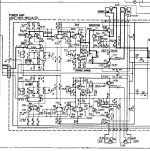This Kenwood Super Eleven came to me with shorted outputs in one channel, along with a few toasted drivers. I replaced the original 2SD555 and 2SB600 with MJ21194 and MJ21193 (both channels) and the other failed transistors with the same part numbers as originally installed. The issue I'm dealing with now is that I'm running out of available bias trimmer range in the original bad channel to reach the recommended 25V--I'm hitting 15mV max, versus 25mV in the other channel with room to spare.
No voltage readings I've taken comparing channels show anything unusual. I've also double-checked the following:
D10, an STV-4H
R44 (new)
VR4 (new)
Q10, Q12, and Q14
Could use another set (or several sets) of eyes on this.

No voltage readings I've taken comparing channels show anything unusual. I've also double-checked the following:
D10, an STV-4H
R44 (new)
VR4 (new)
Q10, Q12, and Q14
Could use another set (or several sets) of eyes on this.

This is almost certainly down to differing characteristics caused by different manufacturing and doping processes of old and new devices.
You could increase the 22 ohm R44 to 27, 33 or 39 ohm to get a bit more bias voltage.
You could increase the 22 ohm R44 to 27, 33 or 39 ohm to get a bit more bias voltage.
This is normal when you have changed output devices.
Can you not replace the 100 Ohm trimmer with a 200 Ohm?
Would this work.
Or if you have put the trimmer to zero Ohm. Then there need to be other change.
Can you not replace the 100 Ohm trimmer with a 200 Ohm?
Would this work.
Or if you have put the trimmer to zero Ohm. Then there need to be other change.
Thanks Mooly and lineup. I thought about increasing R44, but the bias is max with the trimmer at zero ohms.
Bias current should be highest with the trimmer at its highest value. All the trimmer does (at least as it is drawn anyway) is appear in parallel with the 22 ohm. You need higher overall resistance to develop more more voltage across the driver transistor bases.
If the trimmer is at zero ohms then only the diode is developing voltage and that gives minimum bias current.
If the trimmer is at zero ohms then only the diode is developing voltage and that gives minimum bias current.
Yeah, ignore me. It's Friday, and my brain needs it to be Saturday.
I swapped in a 39 ohm resistor, and that did the trick.
I swapped in a 39 ohm resistor, and that did the trick.
- Home
- Amplifiers
- Solid State
- Kenwood Super Eleven Bias Issue